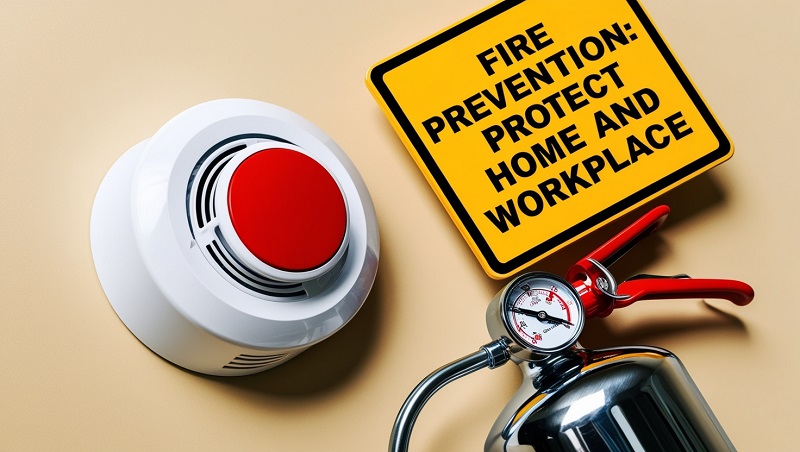How to Prevent a Fire? Fires are among the most devastating emergencies, often resulting in loss of life, property, and environmental damage. However, most fires are preventable with proper precautions and knowledge of fire safety practices. This comprehensive guide outlines effective strategies to prevent fires, reduce risks, and ensure preparedness in both residential and workplace settings.
Why Fire Prevention is Essential
Understanding the importance of fire prevention is key to implementing safety measures. Fires can lead to:
- Loss of Life: Fires can quickly escalate, leaving individuals with little time to escape.
- Property Damage: Entire homes or workplaces can be destroyed, along with irreplaceable belongings.
- Financial Impact: Fires often lead to significant economic losses, including rebuilding costs, medical expenses, and business interruptions.
- Environmental Damage: Wildfires, in particular, devastate ecosystems and contribute to air pollution.
Taking proactive steps to prevent fires can save lives, protect property, and reduce long-term financial and environmental impacts.

Common Causes of Fires
To prevent fires, it’s crucial to understand their most common causes:
- Cooking Accidents: Unattended cooking is the leading cause of residential fires.
- Electrical Malfunctions: Faulty wiring, overloaded outlets, and damaged cords are frequent culprits.
- Heating Equipment: Improper use of space heaters, fireplaces, and other heating devices can ignite fires.
- Smoking: Carelessly discarded cigarettes can lead to house fires.
- Candles: Unattended candles are a common source of ignition.
- Flammable Materials: Improper storage of flammable liquids or materials increases fire risks.
Key Strategies to Prevent Fires
1. Install and Maintain Smoke Alarms
Smoke alarms are your first line of defense in detecting fires early.
- Placement:
- Install smoke alarms on every level of your home.
- Place them inside bedrooms and outside sleeping areas.
- Maintenance:
- Test alarms monthly to ensure they are functioning.
- Replace batteries annually or as soon as the low-battery alert sounds.
- Upgrade: Consider interconnected smoke alarms that sound across the entire house when one is triggered.
2. Practice Safe Cooking Habits
The kitchen is a common area for fires, but practicing safe cooking can prevent most incidents.
- Stay Present: Never leave cooking unattended, especially when frying, grilling, or broiling.
- Keep a Clutter-Free Cooking Area: Remove flammable items like paper towels, wooden utensils, and kitchen towels from around the stovetop.
- Use a Timer: Set timers to avoid forgetting food on the stove or in the oven.
- Invest in a Fire Extinguisher: Keep a Class B or multipurpose fire extinguisher in the kitchen and learn how to use it.
3. Use Heating Equipment Safely
Heating equipment, if not used properly, can ignite fires.
- Space Heaters:
- Keep heaters at least three feet away from anything flammable.
- Always turn off heaters when leaving the room or going to bed.
- Fireplaces:
- Use a sturdy screen to contain sparks.
- Have chimneys cleaned and inspected annually to remove flammable creosote buildup.
4. Handle Electrical Equipment with Care
Electrical malfunctions are a leading cause of fires, but proper handling can mitigate risks.
- Inspect Electrical Systems: Regularly check for damaged wires or frayed cords and replace them immediately.
- Avoid Overloading Outlets: Use surge protectors and avoid plugging too many devices into a single outlet.
- Hire Professionals: For electrical repairs or upgrades, rely on licensed electricians to ensure code compliance.
5. Store Flammable Materials Properly
Improper storage of flammable substances significantly increases fire risks.
- Safe Storage: Keep flammable liquids like gasoline and cleaning agents in tightly sealed containers, stored away from heat sources.
- Ventilation: Ensure well-ventilated areas when using or storing flammable chemicals.
6. Practice Candle Safety
Candles can create a cozy atmosphere, but they require careful handling.
- Supervise Candles: Never leave burning candles unattended.
- Safe Placement: Keep candles away from flammable items like curtains, papers, or furniture.
- Opt for Alternatives: Use battery-operated LED candles for a safer option.
7. Educate Household Members
Fire safety education is essential for everyone in your home.
- Teach Children:
- Educate children about the dangers of fire, matches, and lighters.
- Store matches and lighters out of their reach.
- Emergency Contacts: Ensure everyone knows how to contact local fire services in case of an emergency.
8. Develop and Practice an Escape Plan
Preparation can save lives during a fire.
- Plan Evacuation Routes:
- Identify two ways to exit each room.
- Keep exits clear of obstructions.
- Conduct Fire Drills: Practice fire drills at least twice a year to ensure everyone knows how to evacuate quickly.
- Designate a Meeting Spot: Establish a safe area outside where everyone should gather after evacuating.
9. Install Fire Sprinkler Systems
Fire sprinklers can quickly control or extinguish fires before they spread.
- Automatic Systems: Install sprinkler systems in your home or workplace for added protection.
- Maintenance: Have sprinkler systems inspected regularly to ensure functionality.
Fire Prevention in the Workplace
Fire safety is a legal and moral obligation for employers.
- Emergency Plans: Develop detailed fire evacuation plans and communicate them to all employees.
- Fire Drills: Conduct regular drills to ensure everyone knows the evacuation routes.
- Fire Safety Training: Train employees on using fire extinguishers and recognizing fire hazards.
- Fire Exits: Keep exits unobstructed and clearly marked.
Fire Safety Technology
Modern technology enhances fire prevention and detection.
- Smart Smoke Detectors: Connect to your smartphone for real-time alerts.
- Thermal Imaging Cameras: Detect heat buildup in industrial settings before a fire starts.
- Fire Suppression Systems: Use advanced suppression methods, such as inert gas or chemical systems, for specialized environments.
Conclusion
Fire prevention requires vigilance, education, and proper equipment. By understanding common fire causes and implementing effective strategies, you can significantly reduce the risk of fires in your home or workplace. Regular maintenance, safety training, and modern fire safety technologies play a crucial role in protecting lives, property, and the environment. Remember, prevention is always better than cure.
>>> Read more: Why Is Fire Safety Important?
